N2O Temporal Variability from the Middle Troposphere to the Middle Stratosphere Based on Airborne and Balloon-Borne Observations during the Period 1987–2018
Abstract
1. Introduction
2. Data Description and Methods
2.1. Aircraft and Balloon Observations
2.2. Quality Control and Representativity of the Data
2.3. Data Handling
3. Results and Discussion
3.1. N2O Trend in the UTLS
3.2. N2O Seasonality and Zonal Mean
3.3. Discussion Relative to Atmospheric Circulation and Trends
4. Summary and Outlook
Author Contributions
Funding
Institutional Review Board Statement
Informed Consent Statement
Data Availability Statement
Acknowledgments
Conflicts of Interest
Appendix A. Description of all the Datasets by Time and Campaign
| Date | Campaign | Platform | Instrument | Mission Reference and/or Website |
|---|---|---|---|---|
| 1987 | AAOE | ER2 | ATLAS | [64] |
| WAS | ||||
| DC-8 | WAS | |||
| 1989 | AASE | ER-2 | WAS | [65] |
| ATLAS N2 | ||||
| DC-8 | WAS | |||
| 1989–1999 | OMS | Balloon | SLS | [66] |
| LACE | ||||
| ARGUS N2 | ||||
| MkIV | ||||
| FT | ||||
| ALIAS-II AL | ||||
| 1991 | PEM-WEST-A | DC8 | DACOM | [67] |
| 1991–1992 | AASE-II | ER-2 | ATLAS | [68] |
| ALIAS | ||||
| ARGUS-N2 | ||||
| WAS | ||||
| 1992–1993 | SPADE | ER-2 | ALIAS | [69] |
| ATLAS | ||||
| ACATS | ||||
| 1993–1994 | ATLAS | Shuttle | ATMOS | [70] |
| 1993–1994 | SESAME | Balloon | BONBON | [71] |
| 1994 | ASHOE/MAESA | ER-2 | ACATS | [72] |
| ALIAS | ||||
| ATLAS | ||||
| 1994 | PEM-WEST-B | DC8 | DACOM | [73] |
| 1995–1996 | STRAT | ER-2 | ACATS | [74,75] |
| ATLAS | ||||
| ALIAS | ||||
| 1996 | TRACE-A | DC8 | DACOM | [76] |
| 1997 | POLARIS | ER-2 | ACATS | [77] |
| ATLAS | ||||
| SLS | ||||
| ALIAS | ||||
| 1997–1999 | Balloon | BONBON | ||
| 1999 | PEM-TROPICS-A | DC8 | DACOM | [78] |
| 1999 | ACCENT | WB-57 | LACE | |
| 2000 | SOLVE THESEO 2000 | Balloon | LACE | [79,80,81] |
| SLS | ||||
| MkIV | ||||
| ALIAS | ||||
| DC-8 | ASUR | |||
| DACOM | ||||
| ER-2 | AWAS | |||
| ACATS | ||||
| Unified ACATS/Argus/ALIAS/WAS | ||||
| ARGUS N2 | ||||
| ALIAS | ||||
| 2001–2002 | CNES ODIN validation | Balloon | SPIRALE | [82,83] |
| 2001 | TRACE-P | DC8 | DACOM | [84] |
| 2001–2003 | SPURT | LearJet 35 | TRISTAR | [29,85] |
| 2002–2003 | SCIA-VALUE | Falcon | ASUR | [86] |
| 2002–2007 | BOS | Balloon | AWAS | [87] |
| LACE | ||||
| MkIV | ||||
| FT | ||||
| 2003–2006 | ENVISAT validation | Balloon | SPIRALE | [88,89,90] |
| BONBON | ||||
| 2003 | EUPLEX | Falcon | ASUR | [91] |
| 2003 | SOLVE II | Balloon | MkIV | [92] |
| DC-8 | PANTHER | |||
| DACOM | ||||
| 2005 | PAVE | DC-8 | DACOM | [93,94,95] |
| ASUR | ||||
| 2005 | AVE Houston 2 | WB-57 | AWAS | [94,96] |
| 2006 | CR-AVE | WB-57 | AWAS | [94,97] |
| PANTHER | ||||
| ALIAS | ||||
| 2006 | INTEX-B | DC-8 | DACOM | [98] |
| 2007 | TC4 | DC-8 | DACOM | [99] |
| WB-57 | AWAS | |||
| PANTHER | ||||
| 2008 | FP7 SCOUT-O3 | Balloon | SPIRALE | [100] |
| 2008 | ARCTAS | DC-8 | DACOM DA | [101] |
| UC Irvine Whole Air Sampling | ||||
| 2008 | Start-08 | GV-HIAPER | AWAS | [102] |
| QCLS | ||||
| UCATS | ||||
| 2009 | Balloon | BONBON | ||
| 2009 | STRAPOLETE | Balloon | SPIRALE | [103] |
| 2009 | HIPPO-1 & -2 | GV-HIAPER | QCLS | [104] |
| NWAS | ||||
| WAS | ||||
| UCATS | ||||
| PANTHER | ||||
| 2010 | HIPPO-3 | GV-HIAPER | QCLS | [104] |
| NWAS | ||||
| WAS | ||||
| PANTHER | ||||
| 2010 | GloPac | Global Hawk | UCATS | [105] |
| 1995–2011 | MIPAS-B experiment | Balloon | MIPAS-B | [106] |
| 2011 | ENRICHED | Balloon | BONBON | [107] |
| SPIRALE | ||||
| 2011 | HIPPO-4&5 | GV-HIAPER | QCLS | [104] |
| UCATS | ||||
| NWAS | ||||
| WAS | ||||
| PANTHER | ||||
| 2011 | MACPEX | WB-57 | ALIAS | [108] |
| ALIAS-tracer | ||||
| 2011 | ATTREX | Global Hawk | AWAS | [109] |
| UCATS | ||||
| 2012 | DC3 | DC-8 | DACOM | [110] |
| 2012–2013 | ATTREX | Global Hawk | UCATS | [109] |
| 2012 | TACTS | HALO | TRIHOP | [27] |
| 2013 | AIRTOSS | LEARJET | UMAQS | [32,111] |
| 2013 | GW LCYCLE | Falcon | UMAQS | [112] |
| 2014 | ATTREX | Global Hawk | UCATS | [109] |
| 2016 | POLLSTRACC | HALO | TRIHOP | [28,113] |
| 2016 | KORUS-AQ | DC-8 | DACOM | [114] |
| 2016 | POSIDON | WB-57 | AWAS | [115] |
| PANTHER | ||||
| 2016 | ORCAS | GV-HIAPER | QCLS | [116] |
| 2017 | WISE | HALO | UMAQS | [33,113] |
| 2017 | StratoClim | Geophysica | COLD | [117,118] |
| 2005–2018 | CARIBIC-2 | Airbus A340-600 | TRAC and HIRES | [119] |
| 2016–2018 | Atom missions | DC-8 | PFP | [120] |
| UCATS | ||||
| QCLS | ||||
| PANTHER |
Appendix B
References
- Prather, M.J.; Hsu, J.; DeLuca, N.M.; Jackman, C.H.; Oman, L.D.; Douglass, A.R.; Fleming, E.L.; Strahan, S.E.; Steenrod, S.D.; Sovde, O.A.; et al. Measuring and modelling the lifetime of nitrous oxide including its variability. J. Geophys. Res. Atmos. 2015, 120, 5693–5705. [Google Scholar] [CrossRef]
- Ravishankara, A.R.; Pele, A.-L.; Zhou, L.; Ren, Y.; Zogka, A.; Daele, V.; Idir, M.; Brown, S.S.; Romanias, M.N.; Mellouki, A. Atmospheric loss of nitrous oxide (N2O) is not influenced by its potential reactions with OH and NO3 radicals. Phys. Chem. Chem. Phys. 2019, 21, 24592–24600. [Google Scholar] [CrossRef]
- Myhre, G.; Shindell, D.T. Anthropogenic and Natural Radiative Forcing, Chapter 8. In Climate Change 2013: The Physical Science Basis; Contribution of Working Group I to the Fifth Assessment Report of the Intergovernmental Panel on Climate Change; Jacob, D.J., Ravishankara, A.R., Shine, K., Eds.; Cambridge University Press: Cambridge, UK, 2013; pp. 659–740. [Google Scholar]
- Ciais, P.; Sabine, C.; Bala, G.; Bopp, L.; Brovkin, V.; Canadell, J.; Chhabra, A.; DeFries, R.; Galloway, J.; Heimann, M.; et al. Carbon and Other Biogeochem. Cy. In Climate Change 2013: The Physical Science Basis; Contribution of Working Group I to the Fifth Assessment Report of the Intergovernmental Panel on Climate Change; Stocker, T.F., Qin, D., Plattner, G.-K., Tignor, M., Allen, S.K., Boschung, J., Nauels, A., Xia, Y., Bex, V., Midgley, P.M., Eds.; Cambridge University Press: Cambridge, UK; New York, NY, USA, 2013. [Google Scholar]
- Crutzen, P. A Review of Upper Atmospheric Photochemistry. Can. J. Chem. 1974, 52, 1569–1581. [Google Scholar] [CrossRef]
- Ravishankara, A.R.; Daniel, J.S.; Portmann, R.W. Nitrous oxide (N2O): The dominant ozone-depleting substance emitted in the 21st century. Science 2009, 326, 123–125. [Google Scholar] [CrossRef]
- Brasseur, G.P.; Solomon, S. Aeronomy of the Middle Atmosphere, 3rd ed.; Springer: Dordrecht, The Netherlands, 2005; p. 664. [Google Scholar]
- Elkins, J.W.; Dutton, G.S. Nitrous oxide and sulfur hexafluoride in ‘State of the Climate in 2008. Bull. Am. Meteoro-Log. Soc. 2009, 90, S38–S39. [Google Scholar] [CrossRef]
- Engel, A.; Rigby, M.; Burkholder, J.B.; Fernandez, R.P.; Froidevaux, L.; Hall, B.D.; Hossaini, R.; Saito, T.; Vollmer, M.K.; Yao, B. Update on Ozone-Depleting Substances (ODSs) and other gases of interest to the Montreal Protocol, Chapter 1. In Scientific Assessment of Ozone Depletion: 2018, Global Ozone Research and Monitoring; Project–Report No. 58; World Meteorological Organization: Geneva, Switzerland, 2018. [Google Scholar]
- Webster, C.R.; May, R.D.; Trimble, C.; Chave, R.G.; Kendall, J.E. Aircraft (ER-2) laser infrared absorption spectrometer (ALIAS) for in-situ stratospheric measurements of HCI, N(2)O, CH(4), NO(2), and HNO(3). Appl. Opt. 1994, 33, 454–472. [Google Scholar] [CrossRef]
- Loewenstein, M.; Jost, H.; Grose, J.; Eilers, J.; Lynch, D.; Jensen, S.; Marmie, J. Argus: A new instrument for the measurement of the stratospheric dynamical tracers, N2O and CH4. Spectrochim. Acta A 2002, 58, 2329–2345. [Google Scholar] [CrossRef]
- Kuttippurath, J.; Kleinböhl, A.; Bremer, H.; Küllmann, H.; Notholt, J.; Sinnhuber, B.-M.; Feng, W.; Chipperfield, M. Aircraft measurements and model simulations of stratospheric ozone and N2O: Implications for chemistry and transport processes in the models. J. Atmos. Chem. 2010, 66, 41–64. [Google Scholar] [CrossRef]
- Podolske, J.; Loewenstein, M. Airborne tunable diode laser spectrometer for trace-gas measurement in the lower strato-sphere. Appl. Opt. 1993, 32, 5324–5333. [Google Scholar] [CrossRef] [PubMed]
- Farmer, C.B. High resolution infrared spectroscopy of the Sunand the Earth’s atmosphere from space. Mikrochim. Acta 1987, 3, 189–214. [Google Scholar] [CrossRef]
- Sachse, G.W.; Hill, G.F.; Wade, L.O.; Perry, M.G. Fast-response, high-precision carbon monoxide sensor using a tunable diode laser absorption technique. J. Geophys. Res. 1987, 92, 2071–2081. [Google Scholar] [CrossRef]
- Jucks, K.W.; Johnson, D.G.; Chance, K.V.; Traub, W.A.; Margitan, J.J.; Osterman, G.B.; Salawitch, R.J.; Sasano, Y. Observations of OH, HO2, H2O, and O3 in the upper stratosphere: Implications for HOx photochemistry. Geophys. Res. Lett. 1998, 25, 3935–3938. [Google Scholar] [CrossRef]
- Friedl-Vallon, F.; Maucher, G.; Kleinert, A.; Lengel, A.; Keim, C.; Oelhaf, H.; Fischer, H.; Seefeldner, M.; Trieschmann, O. Design and characterization of the balloon-borne Michelson Interferometer for Passive Atmospheric Sounding (MIPAS-B2). Appl. Opt. 2004, 43, 3335–3355. [Google Scholar] [CrossRef]
- Toon, G.C. The JPL MkIV Interferometer. Opt. Photonics News 1991, 2, 19–21. [Google Scholar] [CrossRef]
- Kort, E.A.; Patra, P.K.; Ishijima, K.; Daube, B.C.; Jiménez, R.; Elkins, J.; Hurst, D.; Moore, F.L.; Sweeney, C.; Wofsy, S.C. Tropospheric distribution and variability of N2O: Evidence for strong tropical emissions. Geophys. Res. Lett. 2011, 38, L15806. [Google Scholar] [CrossRef]
- Santoni, G.W.; Daube, B.C.; Kort, E.A.; Jiménez, R.; Park, S.; Pittman, J.V.; Gottlieb, E.; Xiang, B.; Zahniser, M.S.; Nelson, D.D.; et al. Evaluation of the airborne quantum cascade laser spectrometer (QCLS) measurements of the carbon and greenhouse gas suite–CO2, CH4, N2O, and CO–during the CalNex and HIPPO campaigns. Atmos. Meas. Tech. 2014, 7, 1509–1526. [Google Scholar] [CrossRef]
- Commane, R.; Budney, J.W.; Gonzalez Ramos, Y.; Sargent, M.; Wofsy, S.C.; Daube, B.C. ATom: Measurements from the Quantum Cascade Laser System (QCLS); Version 2; ORNL DAAC: Oak Ridge, TN, USA, 2021. [CrossRef]
- Gonzalez, Y.; Commane, R.; Manninen, E.; Daube, B.C.; Schiferl, L.D.; McManus, J.B.; McKain, K.; Hintsa, E.J.; Elkins, J.W.; Montzka, S.A.; et al. Impact of stratospheric air and surface emissions on tropospheric nitrous ox-ide during Atom. Atmos. Chem. Phys. 2021, 21, 11113–11132. [Google Scholar] [CrossRef]
- Stachnik, R.A.; Millán, L.; Jarnot, R.; Monroe, R.; McLinden, C.; Kühl, S.; Puķīte, J.; Shiotani, M.; Suzuki, M.; Kasai, Y.; et al. Stratospheric BrO abundance measured by a balloon-borne submil-limeterwave radiometer. Atmos. Chem. Phys. 2013, 13, 3307–3319. [Google Scholar] [CrossRef]
- Moreau, G.; Robert, C.; Catoire, V.; Chartier, M.; Camy-Peyret, C.; Huret, N.; Pirre, M.; Pomathiod, L.; Chalumeau, G. SPI-RALE: A multispecies in situ balloonborne instrument with six tunable diode laser spectrometers. Appl. Opt. 2005, 44, 5972–5989. [Google Scholar] [CrossRef] [PubMed]
- AERIS Datacenter. Available online: https://cds-espri.ipsl.upmc.fr/etherTypo/index.php?id=347&L=1 (accessed on 15 December 2022).
- Schiller, C.; Bozem, H.; Gurk, C.; Parchatka, U.; Königstedt, R.; Harris, G.; Lelieveld, J.; Fischer, H. Applications of quantum cascade lasers for sensitive trace gas measurements of CO, CH4, N2O and HCHO. Appl. Phys. B 2008, 92, 419–430. [Google Scholar] [CrossRef]
- Müller, S.; Hoor, P.; Bozem, H.; Gute, E.; Vogel, B.; Zahn, A.; Bönisch, H.; Keber, T.; Krämer, M.; Rolf, C.; et al. Impact of the Asian monsoon on the extratropical lower stratosphere: Trace gas observations during TACTS over Europe 2012. Atmos. Chem. Phys. 2016, 16, 10573–10589. [Google Scholar] [CrossRef]
- Krause, J.; Hoor, P.; Engel, A.; Plöger, F.; Grooß, J.-U.; Bönisch, H.; Keber, T.; Sinnhuber, B.-M.; Woiwode, W.; Oelhaf, H. Mixing and ageing in the polar lower stratosphere in winter 2015–2016. Atmos. Chem. Phys. 2018, 18, 6057–6073. [Google Scholar] [CrossRef]
- Hoor, P.; Gurk, C.; Brunner, D.; Hegglin, M.I.; Wernli, H.; Fischer, H. Seasonality and extent of extratropical TST derived from in-situ CO measurements during SPURT. Atmos. Chem. Phys. 2004, 4, 1427–1442. [Google Scholar] [CrossRef]
- Viciani, S.; D’Amato, F.; Mazzinghi, P.; Castagnoli, F.; Toci, G.; Werle, P.A. Cryogenically operated laser diode spectrometer for airborne measurement of stratospheric trace gases. Appl. Phys. B 2008, 90, 581–592. [Google Scholar] [CrossRef]
- Viciani, S.; Montori, A.; Chiarugi, A.; D’Amato, F. A Portable Quantum Cascade Laser Spectrometer for Atmospheric Meas-urements of Carbon Monoxide. Sensors 2018, 18, 2380. [Google Scholar] [CrossRef] [PubMed]
- Müller, S.; Hoor, P.; Berkes, F.; Bozem, H.; Klingebiel, M.; Reutter, P.; Smit, H.G.J.; Wendisch, M.; Spichtinger, P.; Borrmann, S. In situ detection of stratosphere-troposphere exchange of cirrus particles in the midlatitudes. Geophys. Res. Lett. 2015, 42, 949–955. [Google Scholar] [CrossRef]
- Kunkel, D.; Hoor, P.; Kaluza, T.; Ungermann, J.; Kluschat, B.; Giez, A.; Lachnitt, H.C.; Kaufmann, M.; Riese, M. Evidence of small-scale quasi-isentropic mixing in ridges of extratropical baroclinic waves. Atmos. Chem. Phys. 2019, 19, 12607–12630. [Google Scholar] [CrossRef]
- Elkins, J.W.; Fahey, D.W.; Gilligan, J.M.; Dutton, G.S.; Baring, T.J.; Volk, C.M.; Dunn, R.E.; Myers, R.C.; Montzka, S.A.; Wamsley, P.R.; et al. Airborne gas chromatograph for in situ measurements of long-lived species in the upper troposphere and lower stratosphere. Geophys. Res. Lett. 1996, 23, 347–350. [Google Scholar] [CrossRef]
- Romashkin, P.A.; Hurst, D.F.; Elkins, J.W.; Dutton, G.S.; Fahey, D.W.; Dunn, R.E.; Moore, F.L.; Myers, R.C.; Hall, B.D. In Situ Measurements of Long-Lived Trace Gases in the Lower Stratosphere by Gas Chromatography. J. Atmos. Ocean. Technol. 2001, 18, 1195–1204. [Google Scholar] [CrossRef]
- Hintsa, E.J.; Moore, F.L.; Hurst, D.F.; Dutton, G.S.; Hall, B.D.; Nance, J.D.; Miller, B.R.; Montzka, S.A.; Wolton, L.P.; McClure-Begley, A.; et al. UAS Chromatograph for Atmospheric Trace Species (UCATS)—A versatile instrument for trace gas measurements on airborne platforms. Atmos. Meas. Tech. 2021, 14, 6795–6819. [Google Scholar] [CrossRef]
- Moore, F.L.; Elkins, J.W.; Ray, E.A.; Dutton, G.S.; Dunn, R.E.; Fahey, D.W.; McLaughlin, R.J.; Thompson, T.L.; Romashkin, P.A.; Hurst, D.F.; et al. Balloonborne in situ gas chromatograph for measurements in the troposphere and stratosphere. J. Geophys. Res. 2003, 108, 8330. [Google Scholar] [CrossRef]
- Moore, F.; Dutton, G.; Elkins, J.W.; Hall, B.; Hurst, D.; Nance, J.D.; Thompson, T. PANTHER Data from SOLVE-II through CR-AVE: A Contrast between Long- and Short-Lived Compounds. Am. Geophys. Union 2006, 2006, A41A-0025. [Google Scholar]
- Blake, N.J.; Blake, D.R.; Simpson, I.J.; Meinardi, S.; Swanson, A.L.; Lopez, J.P.; Katzenstein, A.S.; Barletta, B.; Shirai, T.; Atlas, E.; et al. NMHCs and halocarbons in Asian continental outflow during the Transport and Chemical Evolution over the Pacific (TRACE-P) field campaign: Comparison with PEM-West B. J. Geophys. Res. 2003, 108, 8806. [Google Scholar] [CrossRef]
- Heidt, L.E.; Vedder, J.F.; Pollock, W.H.; Lueb, R.A.; Henry, B.E. Trace gases in the Antarctic atmosphere. J. Geophys. Res. 1989, 94, 11599. [Google Scholar] [CrossRef]
- Schauffler, S.M.; Atlas, E.L.; Blake, D.R.; Flocke, F.; Lueb, R.A.; Lee-Taylor, J.M.; Stroud, V.; Travnicek, W. Distributions of brominated organic compounds in the troposphere and lower stratosphere. J. Geophys. Res. 1999, 104, 21513–21535. [Google Scholar] [CrossRef]
- Montzka, S.; Moore, F.; Sweeney, C. ATom: L2 Measurements from the Programmable Flask Package (PFP) Whole Air Sampler; ORNL DAAC: Oak Ridge, TN, USA, 2019. [CrossRef]
- Sweeney, C.; Karion, A.; Wolter, S.; Newberger, T.; Guenther, D.; Higgs, J.A.; Andrews, A.E.; Lang, P.M.; Neff, D.; Dlugokencky, E.; et al. Seasonal climatology of CO2 across North America from aircraft measurements in the NOAA/ESRL Global Greenhouse Gas Reference Network. J. Geophys. Res. D Atmos. 2015, 120, 5155–5190. [Google Scholar] [CrossRef]
- Kaiser, J.; Engel, A.; Borchers, R.; Röckmann, T. Probing stratospheric transport and chemistry with new balloon and aircraft observations of the meridional and vertical N2O isotope distribution. Atmos. Chem. Phys. 2006, 6, 3535–3556. [Google Scholar] [CrossRef]
- Schuck, T.J.; Brenninkmeijer, C.A.M.; Slemr, F.; Xueref-Remy, I.; Zahn, A. Greenhouse gas analysis of air samples col-lectedonboard the CARIBIC passenger aircraft. Atmos. Meas. Tech. 2009, 2, 449–464. [Google Scholar] [CrossRef]
- Comon, P.; Jutten, C. Handbook of Blind Source Separation: Independent Component Analysis and Blind Deconvolution; Academic Press: Oxford, UK, 2010. [Google Scholar]
- Bretherton, C.S.; Smith, C.; Wallace, J.M. An Intercomparison of Methods for Finding Coupled Patterns in Climate Data. J. Clim. 1992, 5, 541–560. [Google Scholar] [CrossRef]
- Wilcox, L.J.; Hoskins, B.J.; Shine, K.P. A global blended tropopause based on ERA data. Part I: Climatology. Q. J. R. Meteorol. Soc. 2012, 138, 561–575. [Google Scholar] [CrossRef]
- Bernath, P.F.; McElroy, C.T.; Abrams, M.C.; Boone, C.D.; Butler, M.; Camy-Peyret, C.; Carleer, M.; Clerbaux, C.; Coheur, P.-F.; Colin, R.; et al. Aeronomy of the Middle Atmosphere, 3rd ed.; Springer: Dordrecht, The Netherlands, 2005; p. 644. [Google Scholar]
- Seinfeld, J.H.; Pandis, S.N. Atmospheric Chemistry and Physics: From Air Pollution to Climate Change, 3rd ed.; Wiley & Sons, Inc.: Hoboken, NJ, USA, 2016. [Google Scholar]
- Bremer, H.; von König, M.; Kleinböhl, A.; Küllmann, H.; Künzi, K.; Bramstedt, K.; Burrows, J.P.; Eichmann, K.-U.; Weber, M.; Goede, A.P.H. Ozone depletion observed by ASUR during the Arctic winter 1999/2000. J. Geophys. Res. 2002, 107, 8277. [Google Scholar] [CrossRef]
- Greenblatt, J.B.; Jost, H.-J.; Loewenstein, M.; Podolske, J.R.; Hurst, D.F.; Elkins, J.W.; Schauffler Atlas, E.L.; Herman, R.L.; Webster, C.R.; Bui, T.P.; et al. Tracer-based determination of vortex descent in the 1999/2000 Arctic winter. J. Geophys. Res. 2002, 107, 8279. [Google Scholar] [CrossRef]
- Niwano, M.; Yamazaki, K.; Shiotani, M. Seasonal and QBO variations of ascent rate in the tropical lower stratosphere as inferred from UARS HALOE trace gas data. J. Geophys. Res. 2003, 108, 4794. [Google Scholar] [CrossRef]
- Mahieu, E.; Chipperfield, M.; Notholt, J.; Reddmann, J.T.; Anderson, J.; Bernath, P.F.; Blumenstock, T.; Coffey, M.T.; Dhomse, S.S.; Feng, W.; et al. Recent Northern Hemisphere stratospheric HCl increase due to atmospheric circulation changes. Nature 2015, 515, 104–107. [Google Scholar] [CrossRef]
- Han, Y.; Tian, W.; Chipperfield, M.P.; Zhang, J.; Wang, F.; Sang, W.; Luo, J.; Feng, W.; Chrysanthou, A.; Tian, H. Attribution of the hemispheric asymmetries in trends of stratospheric trace gases inferred from Microwave Limb Sounder (MLS) meas-urements. J. Geophys. Res. Atmos. 2019, 124, 6283–6293. [Google Scholar] [CrossRef]
- Strahan, S.E.; Smale, D.; Douglass, A.R.; Blumenstock, T.; Hannigan, J.W.; Hase, F.; Jones, N.B.; Mahieu, E.; Notholt, J.; Oman, L.D.; et al. Observed hemispheric asymmetry in stratospheric transport trends from 1994 to 2018. Geophys. Res. Lett. 2020, 47, e2020GL088567. [Google Scholar] [CrossRef]
- Portmann, R.W.; Daniel, J.S.; Ravishankara, A.R. Stratospheric ozone depletion due to nitrous oxide: Influences of other gases. Philos. Trans. R. Soc. Lond. B Biol. Sci. 2012, 367, 1256–1264. [Google Scholar] [CrossRef] [PubMed]
- Revell, L.; Bodeker, G.; Huck, P.; Williamson, B.; Rozanov, E. The sensitivity of stratospheric ozone changes through the 21st century to N2O and CH4. Atmos. Chem. Phys. 2012, 12, 11309–11317. [Google Scholar] [CrossRef]
- Rosenfield, J.E.; Douglass, A.R. Doubled CO2 effects on NOy in a coupled 2D model. Geophys. Res. Lett. 1998, 25, 4381–4384. [Google Scholar] [CrossRef]
- IPCC (Intergovernmental Panel on Climate Change). 2022: Climate Change 2022: Mitigation of Climate Change; Working Group III Contribution to the IPCC Sixth Assessment Report; Cambridge University Press: Cambridge, UK, 2022. [Google Scholar]
- Dhomse, S.S.; Kinnison, D.; Chipperfield, M.P.; Salawitch, R.J.; Cionni, I.; Hegglin, M.I.; Abraham, N.L.; Akiyoshi, H.; Archibald, A.T.; Bednarz, E.M.; et al. Esti-mates of ozone return dates from Chemistry-Climate Model Initiative simulations. Atmos. Chem. Phys. 2018, 18, 8409–8438. [Google Scholar] [CrossRef]
- Minganti, D.; Charillat, S.; Christophe, Y.; Errera, Q.; Abalos, M.; Prignon, M.; Kinnison, D.E.; Mahieu, E. Climatological impact of the Brewer-Dobson circulation on the N2O budget in WACCM, a chemical reanalysis and a CTM driven by four dynamical reanalysis. Atmos. Chem. Phys. 2020, 20, 12609–12631. [Google Scholar] [CrossRef]
- Minganti, D.; Chabrillat, S.; Errera, Q.; Prignon, M.; Kinnison, D.E.; Garcia, R.R.; Abalos, M.; Alsing, J.; Schneider, M.; Smale, D.; et al. Evaluation of the N2O rate of change to understand the stratospheric Brewer-Dobson circulation in a Chemistry-Climate Model. J. Geophys. Res. Atmos. 2022, 127, e2021JD036390. [Google Scholar] [CrossRef] [PubMed]
- AAOE Website. Available online: https://csl.noaa.gov/projects/aaoe/ (accessed on 15 December 2022).
- AASE Website. Available online: https://espo.nasa.gov/aase/ (accessed on 15 December 2022).
- OMS Website. Available online: https://espoarchive.nasa.gov/archive/browse/oms/Balloon (accessed on 15 December 2022).
- Hoell, J.M.; Davis, D.D.; Liu, S.C.; Newell, R.; Shipham, M.; Akimoto, H.; McNeal, R.J.; Bendura, R.J.; Drewry, J.W. Pacific Exploratory Mission-West A (PEM-West A): September–October 1991. J. Geophys. Res. 1996, 101, 1641–1653. [Google Scholar] [CrossRef]
- AASE2 Website. Available online: https://espo.nasa.gov/aase2 (accessed on 15 December 2022).
- SPADE Website. Available online: https://espo.nasa.gov/spade/content/SPADE (accessed on 15 December 2022).
- Gunson, M.R.; Abbas, M.M.; Abrams, M.C.; Allen, M.; Brown, L.R.; Brown, T.L.; Chang, A.Y.; Goldman, A.; Irion, F.W.; Lowes, L.L.; et al. The Atmospheric Trace Molecule Spectroscopy (ATMOS) Experiment: Deployment on the ATLAS space shuttle missions. Geophys. Res. Lett. 1996, 23, 1569. [Google Scholar] [CrossRef]
- Engel, A.; Schmidt, U.; Stachnik, R.A. Partitioning Between Chlorine Reservoir Species Deduced from Observations in the Arctic Winter Stratosphere. J. Atmos. Chem. 1997, 27, 107–126. [Google Scholar] [CrossRef]
- Tuck, A. Introduction to special section: ASHOE/MAESA. J. Geophys. Res. 1997, 102, 3899. [Google Scholar] [CrossRef]
- Hoell, J.M.; Davis, D.D.; Liu, S.C.; Newell, R.; Akimoto, H.; McNeal, R.J.; Bendura, R.J. The Pacific Exploratory Mission-West Phase B: February–March 1994. J. Geophys. Res. 1997, 102, 28223–28239. [Google Scholar] [CrossRef]
- Flocke, F.; Herman, R.L.; Salawitch, R.J.; Atlas, E.L.; Webster, C.R.; Schauffler, S.M.; Lueb, R.A.; May, R.D.; Moyer, E.J.; Rosenlof, K.H.; et al. An examination of the chemistry and transport processes in the tropical lower stratosphere using observations of long-lived and short-lived compounds obtained during STRAT and POLARIS. J. Geophys. Res. 1999, 26, 625–642. [Google Scholar] [CrossRef]
- STRAT Website. Available online: https://espo.nasa.gov/strat/ (accessed on 15 December 2022).
- Andreae, M.O.; Fishman, J.; Lindesay, J. The Southern Tropical Atlantic Region Experiment (STARE): Transport and At-mospheric Chemistry near the Equator--Atlantic (TRACE A) and Southern African Fire-Atmosphere Research Initiative (SAFARI): An introduction. J. Geophys. Res. 1996, 101, 519–520. [Google Scholar] [CrossRef]
- Newman, P.A.; Fahey, D.W.; Brune, W.H.; Kurylo, M.J.; Kawa, S.R. Preface [to special section on Photochemistry of Ozone Loss in the Arctic Region in Summer (POLARIS)]. J. Geophys. Res. 1999, 104, 26481–26495. [Google Scholar] [CrossRef]
- Fuelberg, H.; Newell, R.E.; Westberg, D.J.; Maloney, J.C.; Hannan, J.R.; Martin, B.D.; Avery, M.A.; Zhu, Y. A meteorological overview of the second Pacific Exploratory Mission in the Tropics. J. Geophys. Res. 2001, 106, 427–443. [Google Scholar] [CrossRef]
- Newman, P.A.; Harris, N.R.; Adriani, A.; Amanatidis, G.T.; Anderson, J.G.; Braathen, G.O.; Brune, W.H.; Carslaw, K.S.; Craig, M.S.; DeCola, P.L.; et al. An overview of the SOLVE/THESEO 2000 campaign. J. Geophys. Res. 2002, 107, 8259. [Google Scholar] [CrossRef]
- Hurst, D.F.; Schauffler, S.M.; Greenblatt, J.B.; Jost, H.; Herman, R.L.; Elkins, J.W.; Romashkin, P.A.; Atlas, E.L.; Donnelly, S.G.; Podolske, J.R.; et al. The Construction of a Unified, High-Resolution Nitrous Oxide Data Set for ER-2 Flights During SOLVE. J. Geophys. Res. 2002, 107, 8271. [Google Scholar] [CrossRef]
- SOLVE Website. Available online: https://espo.nasa.gov/solve/ (accessed on 15 December 2022).
- Urban, J.; Lautié, N.; Le Flochmoen, E.; Jimenez, C.; Eriksson, P.; de La Noë, J.; Dupuy, E.; El Amraoui, L.; Frisk, U.; Jégou, F.; et al. Odin/SMR limb observations of stratospheric trace gases: Validation of N2O. J. Geophys. Res. Atmos. 2005, 110, D09301. [Google Scholar] [CrossRef]
- Jégou, F.; Urban, J.; de La Noë, J.; Ricaud, P.; Le Flochmoën, E.; Murtagh, D.P.; Eriksson, P.; Jones, A.; Petelina, S.; Llewellyn, E.J.; et al. Technical Note: Validation of Odin/SMR limb observations of ozone, comparisons with OSIRIS, POAM III, ground-based and balloon-borne instruments. Atmos. Chem. Phys. 2008, 8, 3385–3409. [Google Scholar] [CrossRef]
- Jacob, D.J.; Crawford, J.H.; Kleb, M.M.; Connors, V.S.; Bendura, R.J.; Raper, J.L.; Sachse, G.W.; Gille, J.C.; Emmons, L.; Heald, C.L. Transport and Chemical Evolution over the Pacific (TRACE-P) aircraft mission: Design, execution, and first results. J. Geophys. Res. 2003, 108, 9000. [Google Scholar] [CrossRef]
- Engel, A.; Bönisch, H.; Brunner, D.; Fischer, H.; Franke, H.; Günther, G.; Gurk, C.; Hegglin, M.; Hoor, P.; Königstedt, R.; et al. Highly resolved observations of trace gases in the lowermost stratosphere and upper troposphere from the Spurt project: An overview. Atmos. Chem. Phys. 2006, 6, 283–301. [Google Scholar] [CrossRef]
- Fix, A.; Ehret, G.; Flentje, H.; Poberaj, G.; Gottwald, M.; Finkenzeller, H.; Bremer, H.; Bruns, M.; Burrows, J.P.; Kleinböhl, A.; et al. SCIAMACHY validation by aircraft remote sensing: Design, execution, and first measurement results of the SCIA-VALUE mission. Atmos. Chem. Phys. 2005, 5, 1273–1290. [Google Scholar] [CrossRef]
- BOS Website. Available online: https://espoarchive.nasa.gov/archive/browse/bos (accessed on 15 December 2022).
- Laube, J.C.; Engel, A.; Bönisch, H.; Möbius, T.; Worton, D.R.; Sturges, W.T.; Grunow, K.; Schmidt, U. Contribution of very short-lived organic substances to stratospheric chlorine and bromine in the tropics—A case study. Atmos. Chem. Phys. 2008, 8, 7325–7334. [Google Scholar] [CrossRef]
- Wetzel, G.; Bracher, A.; Funke, B.; Goutail, F.; Hendrick, F.; Lambert, J.-C.; Mikuteit, S.; Piccolo, C.; Pirre, M.; Bazureau, A.; et al. Validation of MIPAS-ENVISAT NO2 operational data. Atmos. Chem. Phys. 2007, 7, 3261–3284. [Google Scholar] [CrossRef]
- Cortesi, U.; Lambert, J.C.; De Clercq, C.; Bianchini, G.; Blumenstock, T.; Bracher, A.; Castelli, E.; Catoire, V.; Chance, K.V.; De Mazière, M.; et al. Geophysical validation of MIPAS-ENVISAT operational ozone data. Atmos. Chem. Phys. 2007, 7, 4807–4867. [Google Scholar] [CrossRef]
- Kleinböhl, A.; Kuttippurath, J.; Sinnhuber, M.; Sinnhuber, B.-M.; Küllmann, H.; Künzi, K.; Notholt, J. Rapid meridional transport of tropical airmasses to the Arctic during the major stratospheric warming in January 2003. Atmos. Chem. Phys. 2005, 5, 1291–1299. [Google Scholar] [CrossRef]
- SOLVE2 Website. Available online: https://espo.nasa.gov/solve2/ (accessed on 15 December 2022).
- Schoeberl, M.R.; Douglass, A.R.; Joiner, J. Introduction to special section on Aura Validation. J. Geophys. Res. 2008, 113, D15S01. [Google Scholar] [CrossRef]
- AVE-POLAR. Available online: https://espo.nasa.gov/ave-polar/ (accessed on 15 December 2022).
- Kleinböhl, A.; Bremer, H.; Küllmann, H.; Kuttippurath, J.; Browell, E.V.; Canty, T.; Salawitch, R.J.; Toon, G.C.; Noholt, J. Dentrification in the Arctic mid-winter 2004/2005 observed by airborne submillimeter radiometry. Geophys. Res. Lett. 2005, 32, L19811. [Google Scholar] [CrossRef]
- AVE-HOUSTON Website. Available online: https://espo.nasa.gov/ave-houston2 (accessed on 15 December 2022).
- AVE-COSTARICA Website. Available online: https://espo.nasa.gov/ave-costarica2/ (accessed on 15 December 2022).
- Singh, H.B.; Brune, W.H.; Crawford, J.H.; Flocke, F.; Jacob, D.J. Chemistry and transport of pollution over the Gulf of Mexico and the Pacific: Spring 2006 INTEX-B campaign overview and first results. Atmos. Chem. Phys. 2009, 9, 2301–2318. [Google Scholar] [CrossRef]
- Toon, O.B.; Starr, D.O.; Jensen, E.J.; Newman, P.A.; Platnick, S.; Schoeberl, M.R.; Wennberg, P.O.; Wofsy, S.C.; Kurylo, M.J.; Maring, H.; et al. Planning, implementation, and first results of the Tropical Composition, Cloud and Climate Coupling Experiment (TC4). J. Geophys. Res. 2010, 115, D00J04. [Google Scholar] [CrossRef]
- Mébarki, Y.; Catoire, V.; Huret, N.; Berthet, G.; Robert, C.; Poulet, G. More evidence for very short-lived substance contribution to stratospheric chlorine inferred from HCl balloon-borne in situ measurements in the tropics. Atmos. Chem. Phys. 2010, 10, 397–409. [Google Scholar] [CrossRef]
- Jacob, D.J.; Crawford, J.H.; Maring, H.; Clarke, A.D.; Dibb, J.E.; Emmons, L.K.; Ferrare, R.A.; Hostetler, C.A.; Russell, P.B.; Singh, H.B.; et al. The Arctic Research of the Composition of the Troposphere from Aircraft and Satellites (ARCTAS) mission: Design, execution, and first results. Atmos. Chem. Phys. 2010, 10, 5191–5212. [Google Scholar] [CrossRef]
- Pan, L.L.; Bowman, K.P.; Atlas, E.L.; Wofsy, S.C.; Zhang, F.; Bresch, J.F.; Ridley, B.A.; Pittman, J.V.; Homeyer, C.R.; Romashkin, P.; et al. The Stratosphere–Troposphere Analyses of Regional Transport 2008 Experiment. Bull. Am. Meteorol. Soc. 2010, 91, 327–342. [Google Scholar] [CrossRef]
- Krysztofiak, G.; Thiéblemont, R.; Huret, N.; Catoire, V.; Té, Y.; Jégou, F.; Coheur, P.F.; Clerbaux, C.; Payan, S.; Drouin, M.A.; et al. Detection in the summer polar stratosphere of air plume pollution from East Asia and North America by balloon-borne in situ CO measurements. Atmos. Chem. Phys. 2012, 12, 11889–11906. [Google Scholar] [CrossRef]
- Wofsy, S.C. HIAPER Pole-to-Pole Observations (HIPPO): Fine-grained, global-scale measurements of climatically important atmospheric gases and aerosols. Phil. Trans. R. Soc. A 2011, 369, 2073–2086. [Google Scholar] [CrossRef] [PubMed]
- GLOPAC Website. Available online: https://espo.nasa.gov/glopac (accessed on 15 December 2022).
- MIPAS Balloon Website. Available online: https://www.imk-asf.kit.edu/english/ffb.php (accessed on 15 December 2022).
- Krysztofiak, G.; Catoire, V.; Té, Y.; Berthet, G.; Toon, G.C.; Jégou, F.; Jeseck, P.; Robert, C. Carbonyl sulphide (OCS) variability with latitude in the atmosphere. Atmos.-Ocean 2014, 53, 89–101. [Google Scholar] [CrossRef]
- MACPEX Website. Available online: https://espo.nasa.gov/macpex (accessed on 15 December 2022).
- Jensen, E.J.; Pfister, L.; Jordan, D.E.; Bui, T.V.; Ueyama, R.; Singh, H.B.; Thornberry, T.D.; Rollins, A.W.; Gao, R.; Fahey, D.W.; et al. The NASA Airborne Tropical Tropopause Experiment: High-Altitude Aircraft Measurements in the Tropical Western Pacific. Bull. Am. Mete-Orol. Soc. 2017, 98, 129–143. Available online: https://journals.ametsoc.org/view/journals/bams/98/1/bams-d-14-00263.1.xml (accessed on 1 July 2021). [CrossRef]
- Barth, M.C.; Cantrell, C.A.; Brune, W.H.; Rutledge, S.A.; Crawford, J.H.; Huntriesser, H.; Carey, L.D.; Ziegler, C. The Deep Convective Clouds and Chemistry (DC3) Field Campaign. Bull. Am. Meteor. Soc. 2015, 96, 1281–1309. [Google Scholar] [CrossRef]
- Frey, W.; Eichler, H.; de Reus, M.; Maser, R.; Wendisch, M.; Borrmann, S. A new airborne tandem platform for collocated measurements of microphysical cloud and radiation properties. Atmos. Meas. Tech. 2009, 2, 147–158. [Google Scholar] [CrossRef]
- Wagner, J.; Dörnbrack, A.; Rapp, M.; Gisinger, S.; Ehard, B.; Bramberger, M.; Witschas, B.; Chouza, F.; Rahm, S.; Mallaun, C.; et al. Observed versus simulated mountain waves over Scandinavia – Improvement of vertical winds, energy and momentum fluxes by enhanced model resolution? Atmos. Chem. Phys. 2017, 17, 4031–4052. [Google Scholar] [CrossRef]
- Oelhaf, H.; Sinnhuber, B.; Woiwode, W.; Bönisch, H.; Bozem, H.; Engel, A.; Fix, A.; Friedl-Vallon, F.; Grooß, J.; Hoor, P.; et al. POLSTRACC: Airborne Experiment for Studying the Polar Stratosphere in a Changing Climate with the High Altitude and Long Range Research Aircraft (HALO). Bull. Am. Meteorol. Soc. 2019, 100, 2634–2664. [Google Scholar] [CrossRef]
- KORUS Website. Available online: https://espo.nasa.gov/korus-aq (accessed on 15 December 2022).
- POSIDON Website. Available online: https://espo.nasa.gov/posidon/ (accessed on 15 December 2022).
- Stephens, B.; Long, M.; Keeling, R.; Kort, E.; Sweeney, C.; Apel, E.; Atlas, E.L.; Beaton, S.; Bent, J.D.; Blake, N.J.; et al. The O2/N2 Ratio and CO2 Airborne Southern Ocean (ORCAS) study. Bull. Am. Meteorol. Soc. 2018, 99, 381–402. [Google Scholar] [CrossRef]
- Bucci, S.; Legras, B.; Sellitto, P.; D’Amato, F.; Viciani, S.; Montori, A.; Chiarugi, A.; Ravegnani, F.; Ulanovsky, A.; Cairo, F.; et al. Deep-convective influence on the upper troposphere–lower stratosphere composition in the Asian monsoon anticyclone region: 2017 StratoClim campaign results. Atmos. Chem. Phys 2020, 20, 12193–12210. [Google Scholar] [CrossRef]
- STRATOCLIM Website. Available online: http://www.stratoclim.org/ (accessed on 15 December 2022).
- CARIBIC Website. Available online: https://www.caribic-atmospheric.com/ (accessed on 15 December 2022).
- Wofsy, S.C.; Afshar, S.; Allen, H.; Apel, E.; Asher, E.; Barletta, B.; Bent, J.; Bian, H.; Biggs, B.; Blake, D.; et al. ATom: Merged Atmospheric Chemistry, Trace Gases, and Aerosols; Version 2; ORNL DAAC: Oak Ridge, TN, USA, 2021. [CrossRef]
- Moussaoui, S.; Carteret, C.; Brie, D.; Mohammad-Djafari, A. Bayesian analysis of spectral mixture data using Markov Chain Monte Carlo methods. Chemom. Intell. Lab. Syst. 2006, 81, 137–148. [Google Scholar] [CrossRef]
- Little, R.J.A.; Rubin, D.B. Statistical Analysis with Missing Data, 2nd ed.; Wiley series in probability and statistics; Wiley: New York, NY, USA, 2002. [Google Scholar]
- Dudok de Wit, T. A method for filling gaps in solar irradiance and solar proxy data. Astron. Astrophys. 2011, 533, A29. [Google Scholar] [CrossRef]
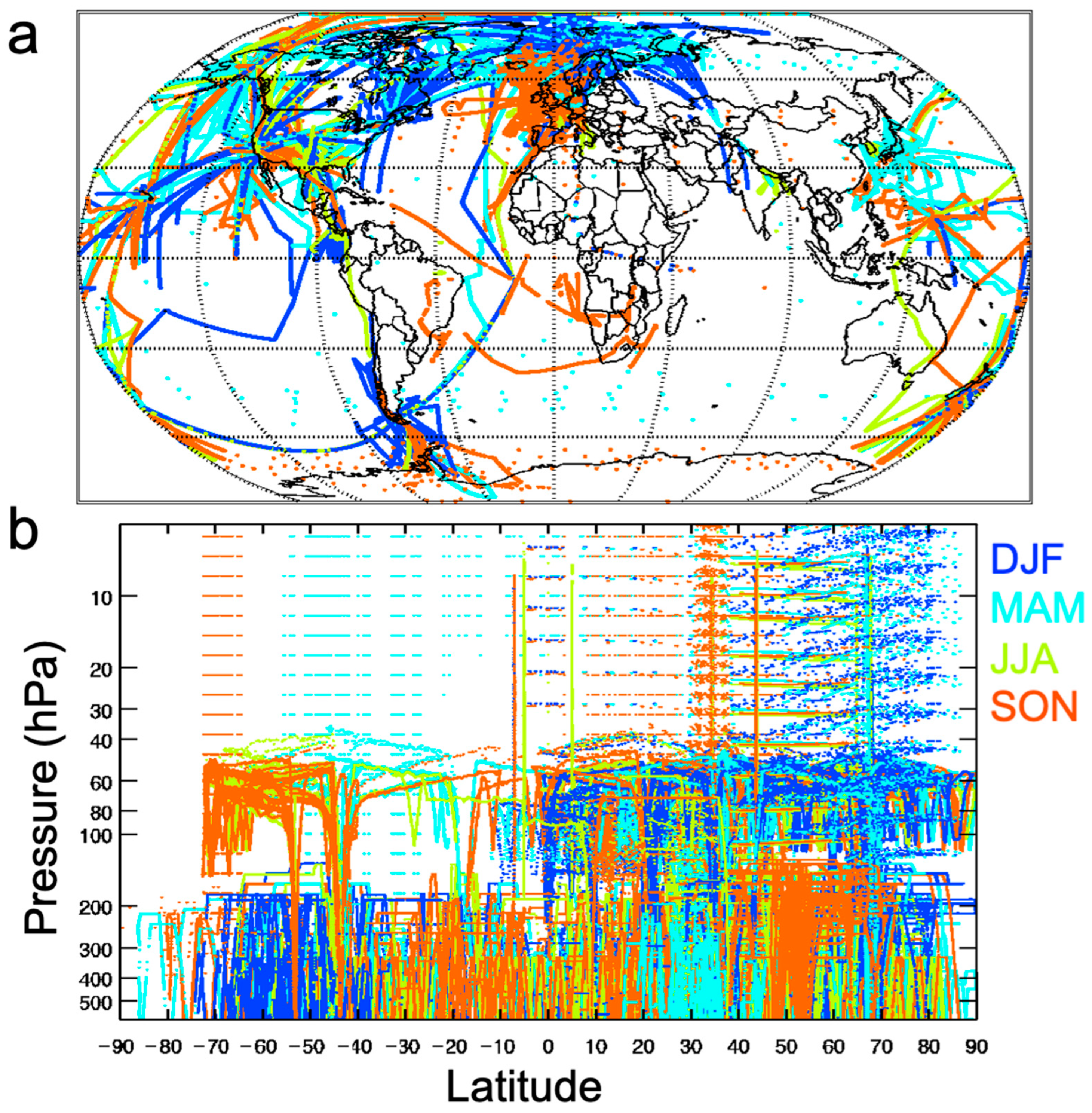
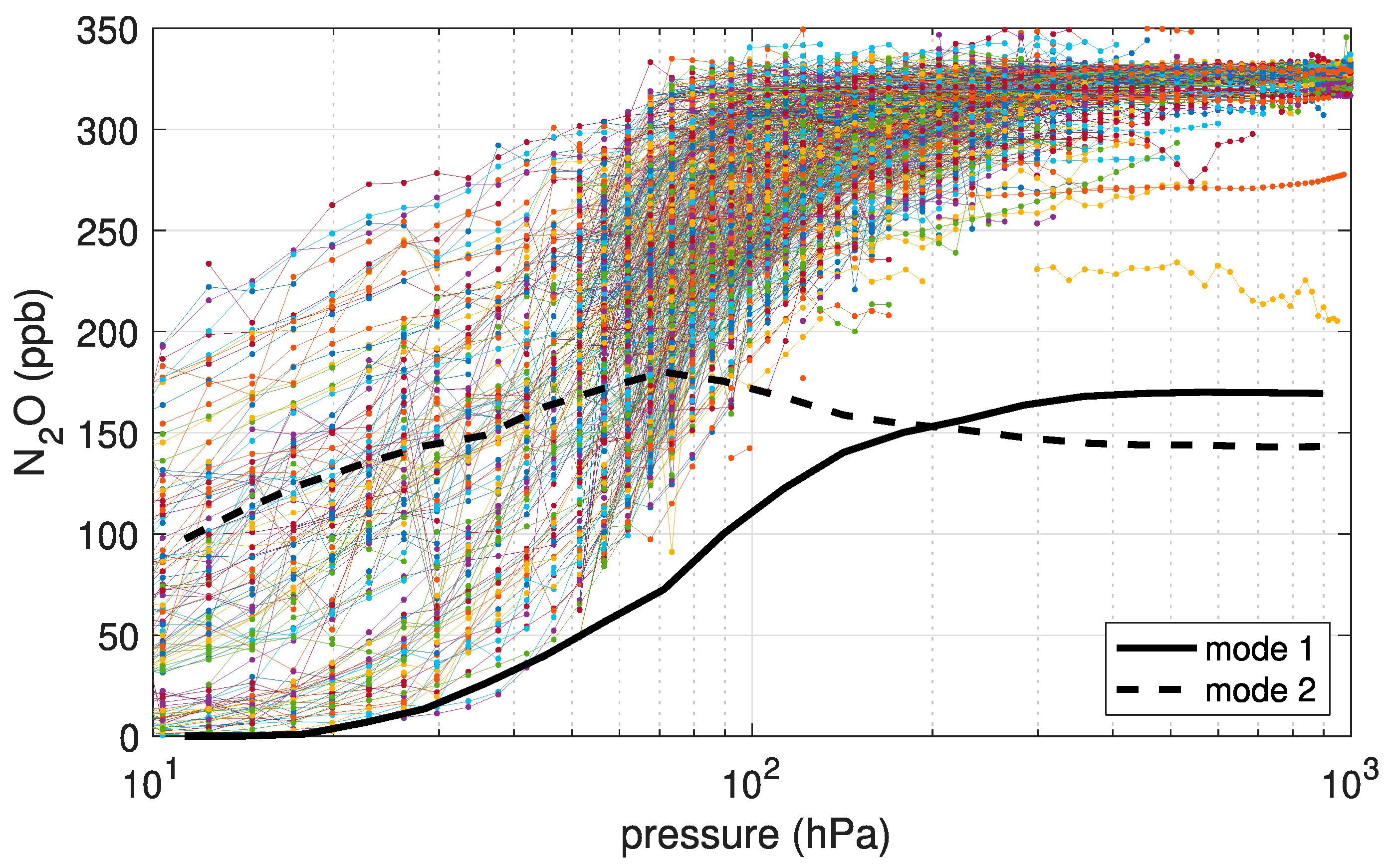
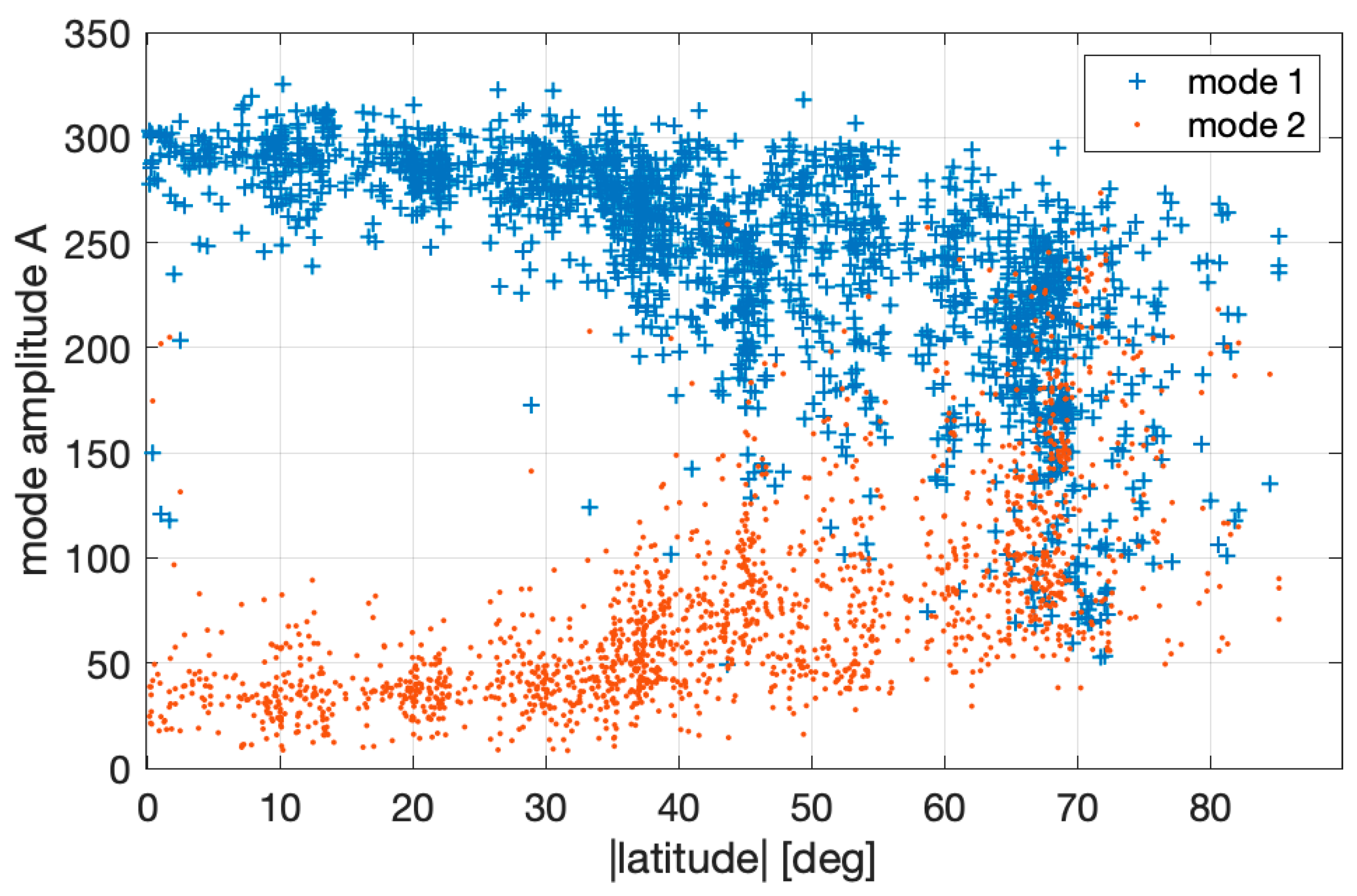
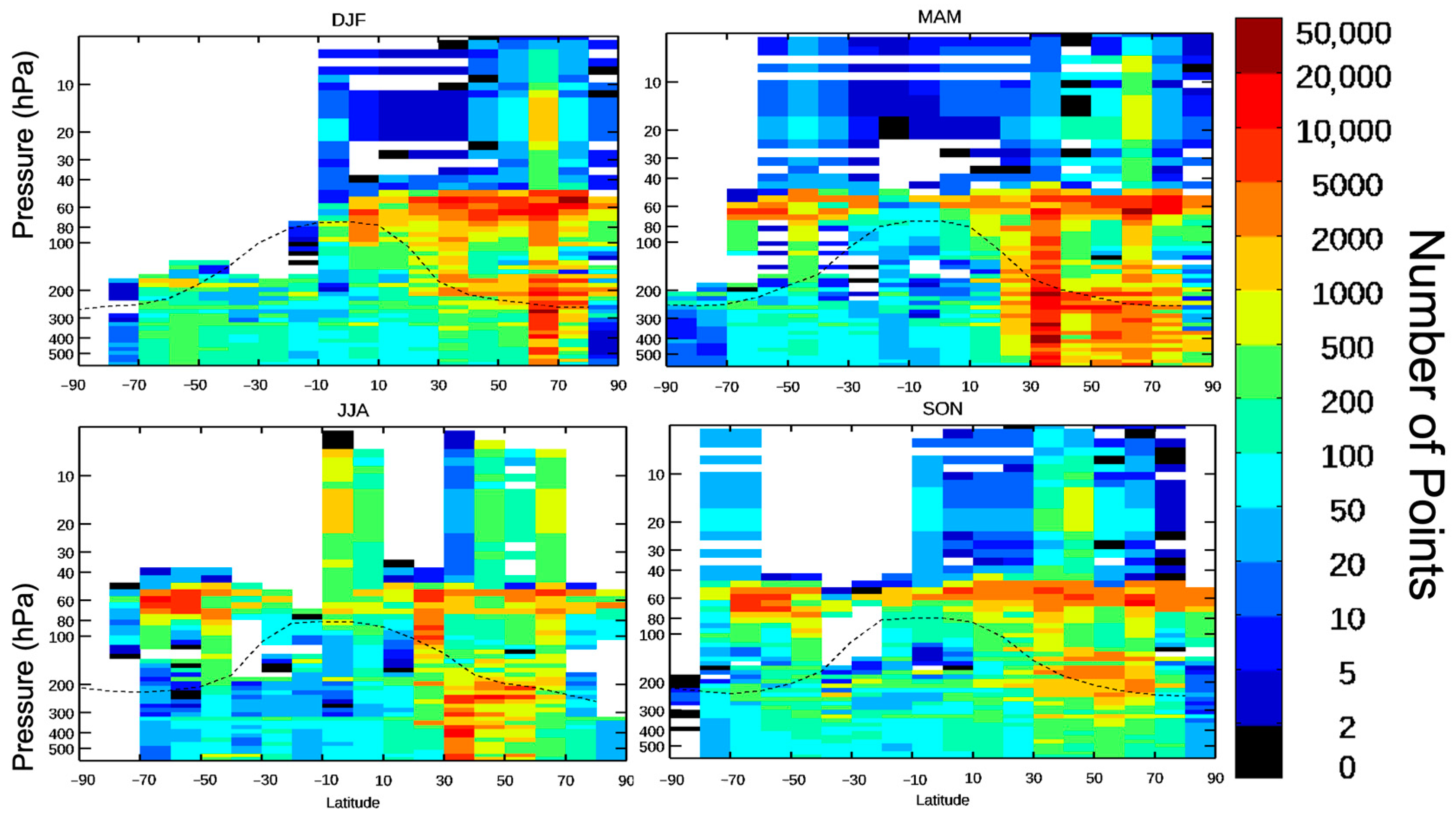
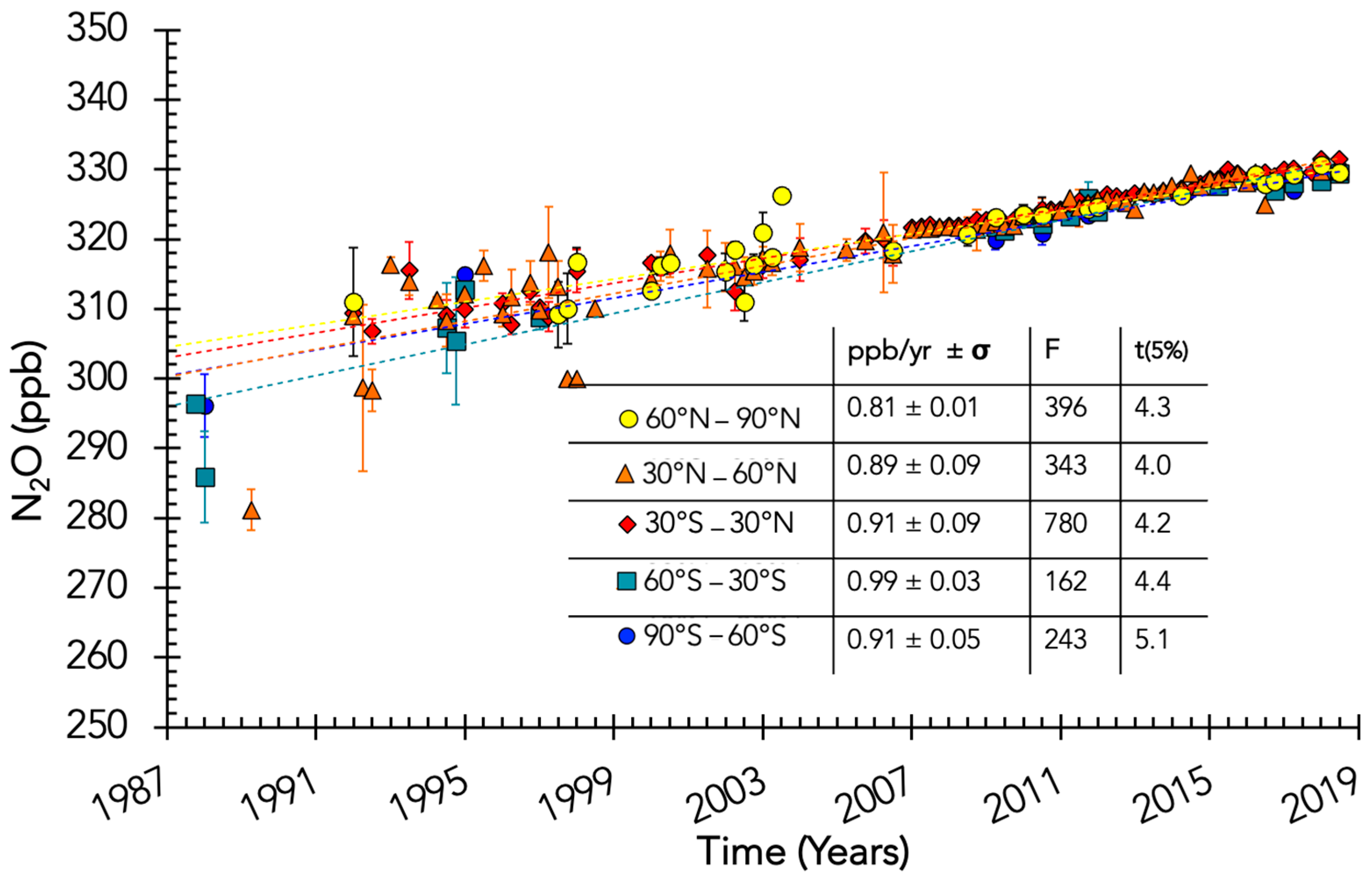
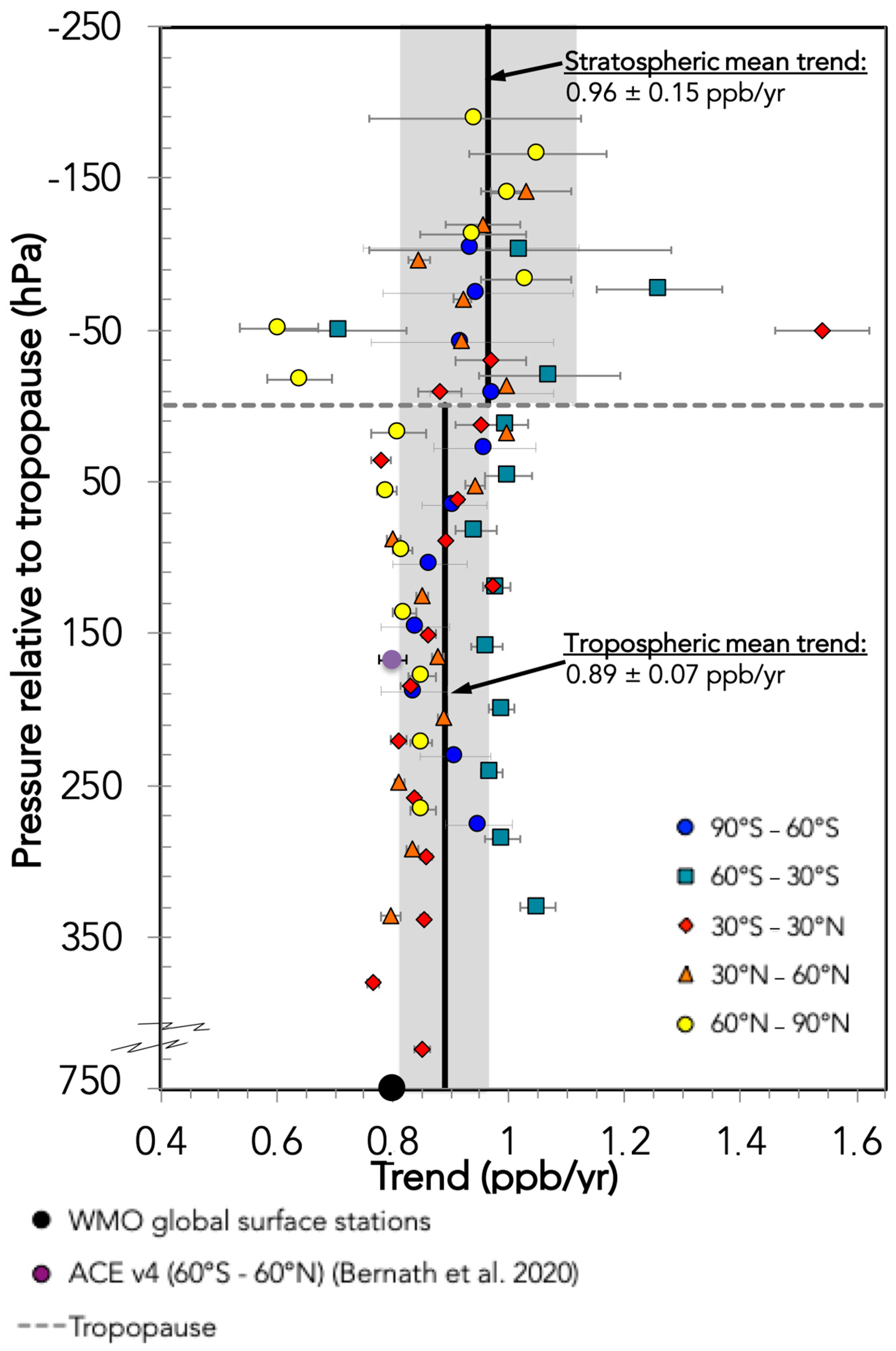


| Instrument | Contact Person | References |
|---|---|---|
| Optical Techniques | ||
| ALIAS | C. R. Webster | [10] |
| ALIAS-II AL | L. Christensen | [10] |
| ARGUS N2 | M. Loewenstein | [11] |
| ASUR | H. Küllmann, A. Kleinböhl | [12] |
| ATLAS | M. Loewenstein | [13] |
| ATLAS N2 | James Podolske | [13] |
| ATMOS | M. R. Gunson | [14] |
| DACOM | G. S. Diskin | [15] |
| FIRS-2 | K. Jucks | [16] |
| MIPAS-B | F. Friedl-Vallon, G. Wetzel | [17] |
| MkIV | G. C. Toon, A. Kleinböhl | [18] |
| QCLS | S. Wofsy | [19,20,21,22] |
| SLS | R. A. Stachnik | [23] |
| SPIRALE | V. Catoire | [24,25] |
| TRIHOP | P. Hoor | [26,27,28] |
| TRISTAR | P. Hoor | [29] |
| COLD2 | S. Viciani, F. Damato | [30,31] |
| UMAQS | P. Hoor | [32,33] |
| Chromatographic techniques | ||
| ACATS | J. W. Elkins, D. Hurst | [34,35] |
| UCATS | D. Hurst, E. Hintsa | [36] |
| LACE | J. W. Elkins, F. Moore | [37] |
| PANTHER | J. W. Elkins, F. Moore | [38] |
| UC Irvine WAS | D. R. Blake | [39] |
| WAS | E. Atlas | [40,41] |
| PFP | S. Montzka | [42,43] |
| BONBON | A. Engel | [44] |
| TRAC and HIRES | T. Schuck, J. Williams | [45] |
Disclaimer/Publisher’s Note: The statements, opinions and data contained in all publications are solely those of the individual author(s) and contributor(s) and not of MDPI and/or the editor(s). MDPI and/or the editor(s) disclaim responsibility for any injury to people or property resulting from any ideas, methods, instructions or products referred to in the content. |
© 2023 by the authors. Licensee MDPI, Basel, Switzerland. This article is an open access article distributed under the terms and conditions of the Creative Commons Attribution (CC BY) license (https://creativecommons.org/licenses/by/4.0/).
Share and Cite
Krysztofiak, G.; Catoire, V.; Dudok de Wit, T.; Kinnison, D.E.; Ravishankara, A.R.; Brocchi, V.; Atlas, E.; Bozem, H.; Commane, R.; D’Amato, F.; et al. N2O Temporal Variability from the Middle Troposphere to the Middle Stratosphere Based on Airborne and Balloon-Borne Observations during the Period 1987–2018. Atmosphere 2023, 14, 585. https://doi.org/10.3390/atmos14030585
Krysztofiak G, Catoire V, Dudok de Wit T, Kinnison DE, Ravishankara AR, Brocchi V, Atlas E, Bozem H, Commane R, D’Amato F, et al. N2O Temporal Variability from the Middle Troposphere to the Middle Stratosphere Based on Airborne and Balloon-Borne Observations during the Period 1987–2018. Atmosphere. 2023; 14(3):585. https://doi.org/10.3390/atmos14030585
Chicago/Turabian StyleKrysztofiak, Gisèle, Valéry Catoire, Thierry Dudok de Wit, Douglas E. Kinnison, A. R. Ravishankara, Vanessa Brocchi, Elliot Atlas, Heiko Bozem, Róisín Commane, Francesco D’Amato, and et al. 2023. "N2O Temporal Variability from the Middle Troposphere to the Middle Stratosphere Based on Airborne and Balloon-Borne Observations during the Period 1987–2018" Atmosphere 14, no. 3: 585. https://doi.org/10.3390/atmos14030585
APA StyleKrysztofiak, G., Catoire, V., Dudok de Wit, T., Kinnison, D. E., Ravishankara, A. R., Brocchi, V., Atlas, E., Bozem, H., Commane, R., D’Amato, F., Daube, B., Diskin, G. S., Engel, A., Friedl-Vallon, F., Hintsa, E., Hurst, D. F., Hoor, P., Jegou, F., Jucks, K. W., ... Wofsy, S. C. (2023). N2O Temporal Variability from the Middle Troposphere to the Middle Stratosphere Based on Airborne and Balloon-Borne Observations during the Period 1987–2018. Atmosphere, 14(3), 585. https://doi.org/10.3390/atmos14030585







